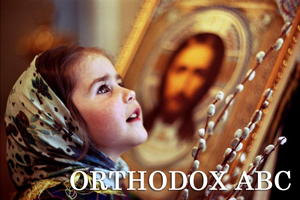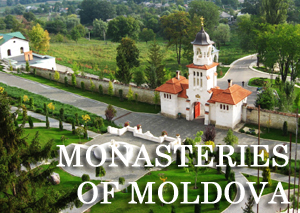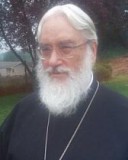
Metropolitan Kallistos of Diokleia
The above article, ‘Orthodoxy in Britain: Its Origins and Future’, originally written in 1989, has been reprinted without any alterations; twenty years later, I continue to hold the same views that I express in it. But it may be helpful to record briefly a few of the main changes that have happened to Orthodoxy in the British Isles during the past two decades.
Not yet old
“Too late have I come to love you, beauty both so old and new, too late have I come to love you”, exclaims St Augustine of Hippo in an invocation to God not far from the end of his Confessions. Orthodoxy in the British isles is also in its own way both old and new. Its newness will be evident at once to anyone who compares this directory, the third to be issued by the Orthodox Fellowship of St John the Baptist, with the Year Book published in
1962 by the Orthodox Youth Association of Great Britain and Ireland. The 1962 Year Book listed 29 Orthodox places of worship, five Bishops, 37 priests and eight deacons. A quarter of a century later, the 1988/89 Directory lists in its statistical section (a new feature) 143 places of worship, twelve bishops, 116 priests and 22 deacons. This indicates how very recent in origin is the great majority of the Orthodox parishes in this country. Eighty per cent of them have existed for less than twenty-five years. Compared with other Christian bodies in this land, the Orthodox
Church is indeed a new presence.
Yet Orthodoxy in Britain is old as well as new. The existing Greek and Russian communities in London have a prehistory’ extending back to the 17th and early 18th centuries. Nor is this all. British Orthodoxy also has roots in this land that are much more ancient. We Orthodox living in Britain today should never forget that the British Isles were converted to Christianity at a time when there was no schism between East and West. Ireland, Scotland, Wales and England were once as much an integral part of the Orthodox world as Greece, Russia, Serbia and Cyprus have
been in recent centuries. We have behind us a thousand years of Orthodoxy on British soil. We are not here as strangers or newcomers. We have as British Orthodox our own local Orthodox saints, our own specific places
of pilgrimage It would be good for us if we knew them better.
I remember how, when I was visiting Greece as a layman, a Greek once said to me, “You must have found it very hard to leave the Church of your fathers.” But another Greek who overheard this interjected, “He has not left the Church of his fathers; he has returned to it.”
PREHISTORY
The story of Orthodoxy in the British Isles since the schism falls into four chapters: first, the period of ‘prehistory’ during the 17th and 18th centuries; second, the beginnings of organized parish life, from the early 19th century until the end of the Second World War; third, the era of major expansion from 1945 to 1970; and fourth, the time of
transition from 1970 onwards. The fact that the stage of ‘beginnings’ extends as late as 1945 underlines very clearly the newness of our Orthodox church life in Britain.
In the early 17th century, at the stage of ‘prehistory’, isolated Greeks begin to appear in different parts of England. Theodore Palaeologus, a descendant of the Byzantine imperial house who died in 1636, lies buried in the churchyard of Landulph in Cornwall. During the reigns of James I and Charles I Oxford harboured several Greeks, such as Christopher Angelos or Angell, author of the earliest account of the Greek Church written for English readers, and also a future Patriarch of Alexandria, Metrophanes Kritopoulos. Another Greek at Oxford from 1637 to 1648, Nathaniel Canopius, exercised an influence on our national life more decisive than any other Orthodox
has so far done up to the present, for he is credited with introducing coffee-drinking into England. What, one wonders, did these Greeks do about Holy Communion? Kritopoulos and Canopius were both priests, but I know of no evidence to suggest that they celebrated the Orthodox Liturgy while at Oxford. More probably they and Angell simply ‘conformed’, attending the Anglican services in their college chapels. Later in the 17th century, from 1694 to 1704, there was even an attempt to establish a ‘Greek College’ at Oxford, but the scheme was overambitious and came to nothing.
The first Orthodox Church to be opened in London was established in 1677 by the exiled Greek Archbishop of Samos, Joseph Georgirenes, in the then fashionable district of Soho. Its memory is still preserved in the name ‘Greek Street’. It proved short-lived, and was closed around 1682. The Bishop of London, Henry Compton, was unsympathetic to Orthodox practices: considering that the Greek church in Soho came under his own episcopal jurisdiction, he demanded of its clergy that they should use no icons and should refrain from invoking the Mother
of God and the saints in their services. But the next Orthodox place of worship opened in London, the Russian Embassy chapel, founded around 1721, enjoyed diplomatic immunity and so was free from interference by the Bishop of London. For more than a century this was the only Orthodox church in Britain, and Greek clergy as well as Russian served there on a regular basis.
Two unexpected Orthodox contacts occurred later in the 18th century. Orthodoxy was involved in the origins of Methodism. In 1763 John Wesley, unable to find any Anglican bishop willing to ordain his preachers, somewhat surprisingly invited an exiled Greek bishop living in Amsterdam, known as Erasmus or Gerasimos, to perform an ordination for him. Yet more surprisingly, Erasmus agreed to come and do this. It is possible that Wesley was
duped by an impostor, but on the whole this seems unlikely. Three decades later, in 1791, Frederick North, a young member of the English aristocracy, the son of a former prime minister, was received into the Orthodox Church in Corfu. Later he was elected Member of Parliament for Banbury, and up to the present time, so far as I know, he remains the only Orthodox to have sat in the House of Commons. (The late Gerald Palmer, translator of the Philokalia, who died in 1984, was Member of Parliament for Winchester from 1935 to 1945, but this was before he had joined the Orthodox Church.) North, who afterwards became Governor-General of Ceylon and fifth Earl of Guildford, kept his Orthodoxy secret, but remained faithful to it until the end of his life. In the registers of the Russian embassy chapel preserved in the Public Record Office, the Chaplain Fr Yakov Smirnov records that he visited North on 13 October 1827, to give him communion on his death-bed.
THE BE GINNINGS OF PA RISH LIFE
The second chapter of the story, the beginnings of organised parish life, starts with the arrival of Greek refugees in
the years following 1821. Fleeing from Turkish reprisals during the Greek War of Independence, they came especially from the island of Chios. In the later 19th century they had grown into a wealthy community, mainly of shipowners, but they were never large in number. Some of them intermarried with the English upper classes and became Anglicans. A Greek church was opened in the City in 1838; services at the present Greek Cathedral of St Sophia in Bayswater began in 1879. Meanwhile in 1843 a Greek church was established in Manchester (the present
building dates from 1861), while further churches were opened at Liverpool in 1870 and at Cardiff on the eve of the First World War. Between the two World Wars, however, no further Greek parish was established, and so the total number of churches up to the late 1940s was no more than four. The first Orthodox hierarch to reside permanently in
this country was Metropolitan Germanos of Thyateira; appointed in 1922, he remained in office until his death in 1951.
On the Russian side, there was a modest increase in numbers following the 1917 Revolution, but the bulk of the Russian émigrés went to Paris or Berlin rather than London. After the closure of the embassy chapel, the Anglicans in 1921 put St Philip’s Church, Buckingham Palace Road, at the disposal of the Russian community. In 1926 the Russian parish split between the ‘Evlogy’ and the ‘Karlovtsy’ jurisdictions, but both groups continued to share the same church, each using it on alternative Sundays, an arrangement that continued until St Philip’s was demolished in 1956. The ‘Evlogy’ parish passed under the Moscow Patriarchate in 1945. Up to the Second World War, then, the Russians were limited to a single church in London, and did not build up any parish network outside the capital.
EXPANSION , CONSOLIDATION , TRANSITION
The real time of Orthodox expansion came only in the third period, 1945-70. There were two major developments in
the post-war years. There was first a wave of Orthodox immigrants from Eastern Europe, far larger than that which followed the 1917 Revolution, and not limited to Russians but including Serbs, Ukrainians, Byelorussians and Poles. Within a few years Slav parishes had been founded across the Midlands in most of the major industrial towns. Secondly, from the late 1940s onwards there was also a major influx of Greeks from Cyprus. A second Greek parish in London, serving mainly the Cypriots, was opened in Camden Town in 1947. By the early sixties there were eleven Greek parishes in Britain, four of them in London, but these were altogether insufficient to meet the pastoral
needs of a Greek community that now numbered about 150-200,000. Large-scale parochial development only began with the arrival of Metropolitan (later Archbishop) Athenagoras II of Thyateira in 1964. Within six years the eleven parishes had increased five-fold to more than fifty, and at the same time a fundamental diocesan reorganization was taken in hand, involving the establishment of a proper central office, the publication of a magazine, the holding of clergy-laity conferences, and a regular programme of charitable and youth work.
What of the present, from 1970 onwards? In the Greek Archdiocese expansion has continued, but at a more moderate pace. The most striking rate of growth has been in the Russian Patriarchal Diocese of Sourozh. Whereas it listed only a single parish outside London in the 1962 Year Book, it now has over twenty eucharistic centres in different parts of the country, although some of these are quite small in size. The period since 1970 may be characterized above all as a time of transition. A new generation of Orthodox born and educated in this country,
usually speaking nothing but English, has been growing up alongside the original immigrants: We are ceasing to be a Church of foreigners, a Church of the ‘Diaspora’, and we are developing into a local Church with firm cultural roots in this land. The process of transition has progressed furthest in the Russian Patriarchal Diocese, finding articulate expression at the annual diocesan conferences held in Effingham since 1974 under Metropolitan Anthony. The transition is less far advanced in the Greek and Serbian parishes, yet here too the same factors are plainly at work.
The transition, as we all know, poses urgent pastoral problems. The immigrant Orthodox, whether or not they are active in supporting their Church, will never cease – save in rare cases – to look on themselves as Orthodox. But what of their children? All Christian bodies in Britain are losing their young people at an alarming rate; but the
sharp cultural shift from immigrant parents to children born and brought up in this country makes us Orthodox particularly vulnerable to the loss of our youth. It is certainly possible that during the next few decades we shall see Orthodoxy in Britain shrink rather than expand. There are many different lines of approach to the problem – more literature and church teaching for our children, more youth camps, more English at services – but there is no simple solution. Above all, in the Greek Archdiocese there is a need to find future priests among the members of the new generation in Britain, instead of importing almost all of them ‘ready-made’ from Greece or Cyprus. One priority for British Orthodoxy in the immediate future is surely to provide a more effective programme for training clergy in this country.
The number of converts to Orthodoxy in Britain remains restricted. About twenty per cent of the clergy listed in this Directory are people who have joined the Orthodox Church as adults, but the proportion of converts among the laity is very much smaller – perhaps less than one per cent of the total number of Orthodox in this land. Yet the converts, with their varied gifts and their roots in the local cultures, may have a role to play in the present time of transition out of all proportion to their numbers.
Among the converts and within the newgeneration of Orthodox born and brought up in this country, there is a deep desire for fullerOrthodox unity. We value the distinctiveriches that we have received and continue toreceive from the various Orthodox nationaltraditions – Greek, Arab, Russian, Serbian,Romanian – and we have no desire to see
this life-giving diversity extinguished. But welong also for more effective inter-Orthodoxco-operation. Such precisely is the task towhich the Fellowship of St John the Baptistis dedicated.
The process of transition is far fromcomplete. It may well be that in the nexttwenty-five years the outward form ofOrthodoxy in the British Isles will be changedin ways that none of us can foresee.
Source: Sourozh Magazine, No. 106, pp. 18-22
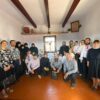 Memorial house of romanian elder Sofian Boghiu Consecrated in his native Village
Memorial house of romanian elder Sofian Boghiu Consecrated in his native Village 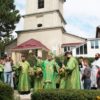 On the 14th Sunday after Pentecost, His Eminence Metropolitan Vladimir celebrated the Divine Liturgy in the St. Nicolas Monastery, Dobrusa village, Soldanesti region
On the 14th Sunday after Pentecost, His Eminence Metropolitan Vladimir celebrated the Divine Liturgy in the St. Nicolas Monastery, Dobrusa village, Soldanesti region 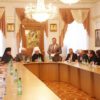 Inauguration of the volume of articles presented at the National Scientific Conference “The Orthodox Church and the State: Faith and Knowledge”
Inauguration of the volume of articles presented at the National Scientific Conference “The Orthodox Church and the State: Faith and Knowledge” 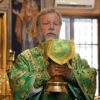 The 12th Sunday after Pentecost – kindness in God changes the world we live in
The 12th Sunday after Pentecost – kindness in God changes the world we live in 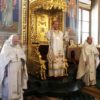 The 11th Sunday after Pentecost – loving our God and our neighbor
The 11th Sunday after Pentecost – loving our God and our neighbor 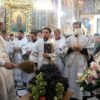 The Transfiguration of the Lord, celebrated in the Nativity of the Lord Cathedral in Chisinau
The Transfiguration of the Lord, celebrated in the Nativity of the Lord Cathedral in Chisinau 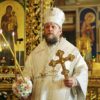 His Eminence Metropolitan Vladimir celebrates 65th anniversary
His Eminence Metropolitan Vladimir celebrates 65th anniversary  Divine Service at the St. Theodore of Tyre Monastery (Ciuflea) in Chisinau, and congratulation of Archimandrite Nicolae (Rosca), the Monastery’s confessor-administrator, on the 50th anniversary.
Divine Service at the St. Theodore of Tyre Monastery (Ciuflea) in Chisinau, and congratulation of Archimandrite Nicolae (Rosca), the Monastery’s confessor-administrator, on the 50th anniversary.  The Tenth Sunday after Pentecost: Divine Liturgy in the Nativity of the Lord Cathedral in Chisinau
The Tenth Sunday after Pentecost: Divine Liturgy in the Nativity of the Lord Cathedral in Chisinau 
